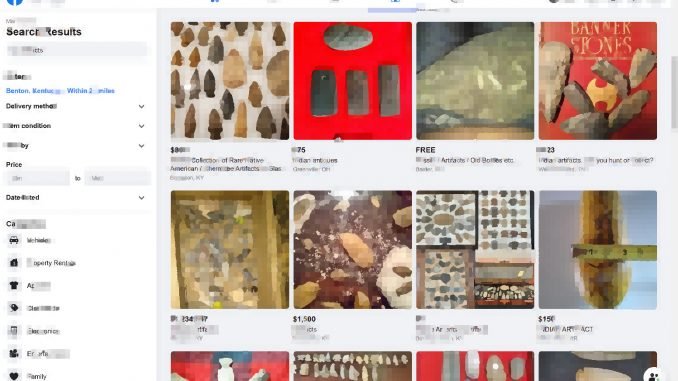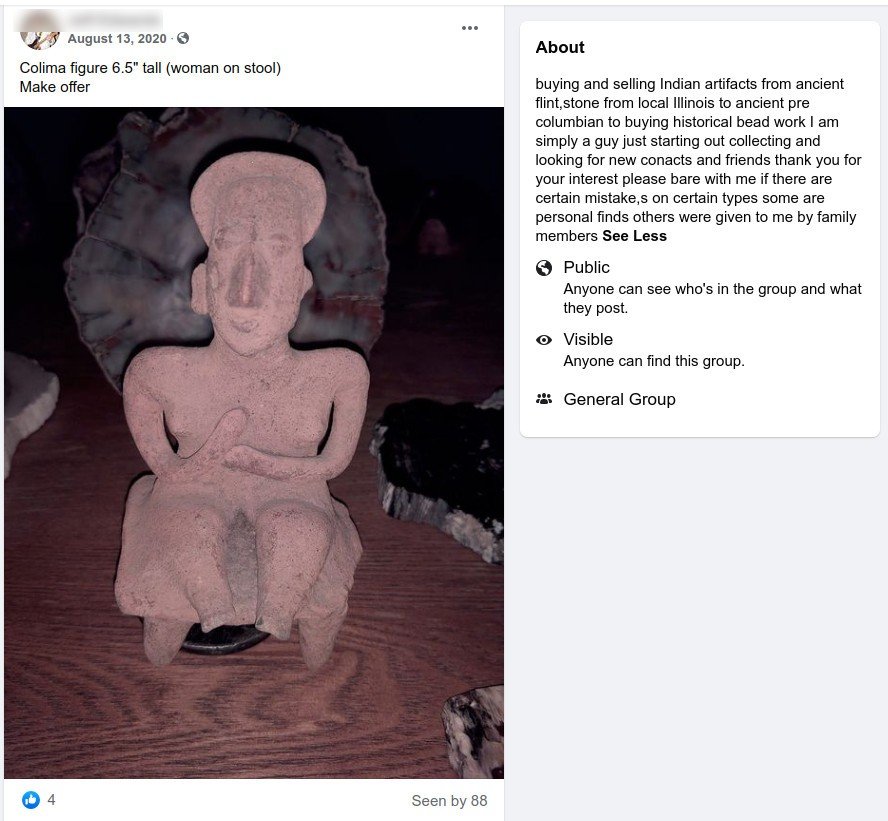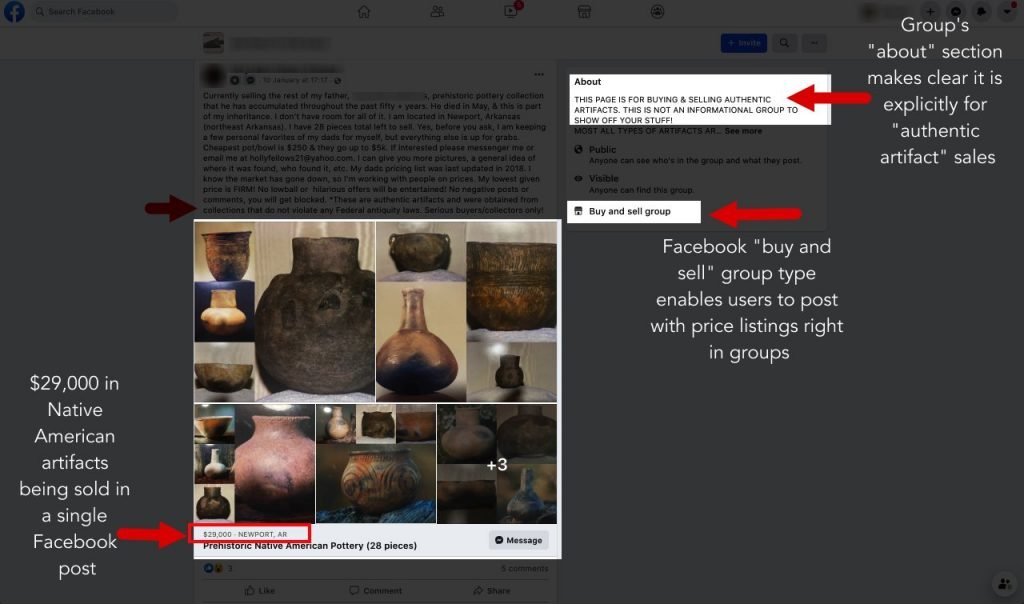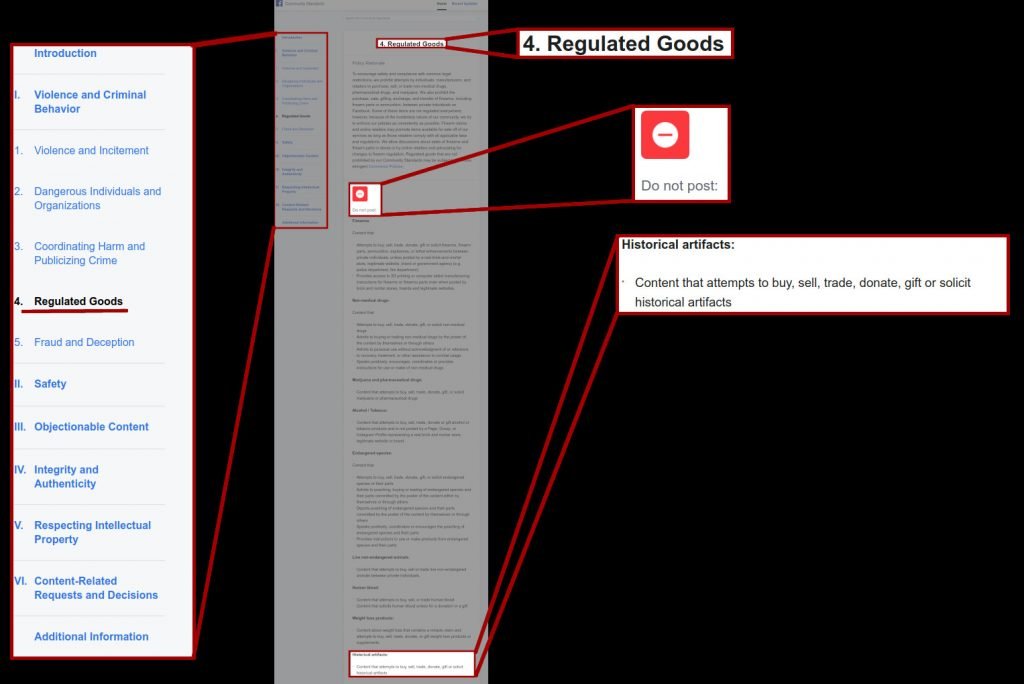
The antiquities marketplace on Facebook is alive and well in spite of their own rules against it.
Facebook Community Standards
In June of 2020, Facebook created some new community standards, among them was a ban on “content that attempts to buy, sell, trade, donate, or solicit historical artifacts.”
The rule about banning historical artifacts is, as of this writing, in the Facebook Community Standards, under “Regulated Goods” and below a “Do not post:” warning.
This was initially perceived as good news by myself and a few others, but we noticed right away that it wasn’t being enforced. Within days, I think I reported a handful of buy/sell groups, each time only to be notified that Facebook had received the report but found that it did not violate their community standards. I thought, at the time, that this would be something that would fix itself over time as FB employees and algorithms got up to speed. But now, over half a year later, these buy/sell sites are still at it. And Covid lockdowns have been very good for illegal antiquities trade.
Within the past couple of weeks, I again reported a handful of groups and, again, was told that they didn’t violate the Facebook Community Standards.

in a Facebook Buy/Sell group. In Mexico’s
Colima culture, figurines like this were often
included as grave goods, implying there’s a
good chance one or more graves were
disturbed to retrieve this artifact. Without
question, the artifact’s most valuable aspect is
utterly destroyed: its context.
So what’s the issue with buying and selling antiquities?
There are several. First and foremost it’s an ethics question. In many cases, it’s illegal. And, very often, it funds illegal activities.
I realize there are no doubt many who will read this and think, if a person is on private land and digs up artifacts, this should be completely legal. And very often is, at least in the United States. But “legal” and “ethical” aren’t necessarily the same. In addition, legalities even on private land can change if the object is a funerary object and part of a grave. Though some states still favor the landowner.
Native American traditions from Canada to Peru include placing grave goods with those that are interred. These grave goods can include clay figurines, obsidian, beadwork, jewelry made from shells or semi-precious stones, pottery (often containing foodstuffs), and household goods like spindle whorls or metates. An example of this sort of artifact assemblage is found with the Colima culture of Western Mexico where such grave goods are added to their shaft graves.
And it’s the artifact’s assemblage that allows for context. Context is culmination of artifacts, features, and environment, as well as abstract ideas like culture and society, which form the circumstances that created, caused, deposited, or allowed the artifact to exist. The context tells the story of the person or people associated with the artifact. Sometimes that story is as complete as a novel or even a compendium! But sometimes it’s a just brief note; barely a sentence to tell the story of an entire civilization. It all depends on how well the context is revealed.
Are we being responsible stewards of the past?
And herein lies the ethical dilemma of “artifact hunting” by advocationalists, diggers, land-owners, hobbyists, collectors, and–sometimes–even archaeologists. Are we being a responsible steward of the past?
Ask any collector or seller on any of these buy-sell groups for arrowheads and ancient artifacts (at least in teh United States), and you’ll probably hear them say something like “I love history” or “I want to share these bits of the past with others.” Or something very similar. Even among those making tens of thousands of dollars from their finds. There are some exceptions, but this is a very common response.

selling of pre-Columbian and ancient artifacts
And it’s extremely hard to convince such people that what they’re doing is wrong. It really isn’t hard to emphasize with them. You look down, you see a bifacial point (a.k.a. an arrowhead). We’re all picking it up. Not many of us are putting it back down and walking away. Those of us that do are probably archaeologists thinking of the ethics. But for the average enthusiast, the ethics don’t even exist.
The larger question of context just isn’t something the average enthusiast considers. From their point of view, archaeologists are just stuffy, armchair academics that want to selfishly collect all the good stuff for themselves. Which is kind of our fault. We’re not doing a good enough job sharing the importance of context with the interested public. But making soil stains awesome is hard. And when you start dropping terms like “stratigraphy” and “taphonomic processes,” it just reinforces the “stuffy academic” opinion.
Yet try to educate we must.
And it may just be that we need to educate Facebook as well.
Standards Violations Without Consequence
With the dearth of Facebook groups that still exist and are still being created since June 2020, we have to ask what was Facebook’s goal with including the restriction on buying and selling historic artifacts?
If I had to make a guess, it would be in response to the illegal antiquities trade on a more global scale which has been shown to support both terrorism and the drug trade. In the recent past, portable antiquities from Syria and Iraq have ended up on the black market, sold through middle-men by entities like ISIS and other extremist groups. Funds from these sales gets funneled right back to the terrorists to purchase weapons, food, equipment, etc.
In Thailand and Cambodia, the antiquities trade is a multi-billion dollar industry. One that has taken advantage of continued civil unrest and regular outbreaks of civil war in the region since the 1960s. And because wealthy Western collectors are willing to pay handsomely for cultural resources, archaeological sites such as Angkor Wat and Koh Ker have been devastated by looters. Indeed, archaeological sites that may never be studied or even known by professionals are literally stripped bare of their material remains, the contexts of civilizations irrevocably destroyed, the heritage of local descendent communities forever lost. Often at their own hands.

Image Courtesy of the @ATHARProject
Without a doubt, these are vile activities from which Facebook would like to disassociate itself. All over the world, the antiquities trade is variously linked not just from looted sites to wealthy collectors, but also to other illicit activities including drug and wildlife trafficking, prostitution, the funding of terrorism and criminal enterprises, and so on.
And yet, Facebook still permits hundreds if not thousands of groups to exist that are set up specifically to sell antiquities. The very historic artifacts trade they prohibit. And, when they are reported, little or nothing is done.
The Antiquities Trafficking Heritage Anthropology Research Project (ATHAR) told me: “we’ve tested Facebook’s policy by reporting content. Only one of roughly a dozen reported posts explicitly offering artifacts were removed. In some cases the posts violated multiple platform policies.”
And they’re right.
So why doesn’t Facebook enforce their own Community Standards?
The answer might be that the photographs are evidence and can help the good guys find the sites; find the looters; track down the traffickers; and so on. But I don’t believe this to be true. It would not be a difficult matter for Facebook to archive the photos and even make them available to authorities in relative localities.
But more than this, the antiquities trade is motivated by the collector and the buyer. Like the trade in restricted wildlife and biological remains (pangolins, ivory, etc.), the antiquities trade is entirely consumer driven. Without collectors, the looters would not have a reason to dig. The well is the money made from the sale of antiquities, not the antiquities themselves.
When the well dries up (collectors stop buying), why would anyone want to risk jail or participate in the intensive labor needed to dig up the artifacts?
So if Facebook has a rule, why aren’t they acting on it?
When pressed by NPR, a Facebook representative finally said, “we’re committed to enforcing the policy; because the policy is relatively new, we are compiling training data to inform our systems so we can better enforce. It’s an area where we are going to improve with time.”
That was in July of 2020.
What Can You Do?
You can report the violations where you see them. If you come across a buy-sell-trade group for antiquities, report them. If you administer or moderate a Facebook group, don’t allow linking or sharing of these sorts of messages and posts. If you know someone that’s involved, let them know it goes against Facebook Community Standards–give them the link to see it for themselves.

Be sure to click “Report Group” on the next screen before clicking “done.”
If you’re a cultural heritage professional, make time to educate the general public on what antiquities are, why context is important, and encourage them to take photographs of the things they see but leave them in place.
When it comes to “arrowhead hunters,” try to be nice to them. Don’t use loaded terms like “looting and looters,” as hard as it may be. You may never win them over to embracing our ethical point of view, but unkind or harsh treatment will certainly not help. They may never change their minds, but at least they can’t blame it on “the asshole archaeologist” that disparaged their hobby.
Finally, follow a few resources like:
- The Antiquities Trafficking and Heritage Anthropology Research (ATHAR) Project by clicking the link or follow them on Twitter @ATHARProject.
- The Antiquities Coalition at the link or also follow on Twitter @CombatLooting.
- SAFE / Saving Antiquities
As you click the links in this article above, you’ll notice something consistent: ATHAR is mentioned over and over by NPR, Forbes, and news outlets like The Art News. I highly recommend following them on Twitter.

Leave a Reply
You must be logged in to post a comment.